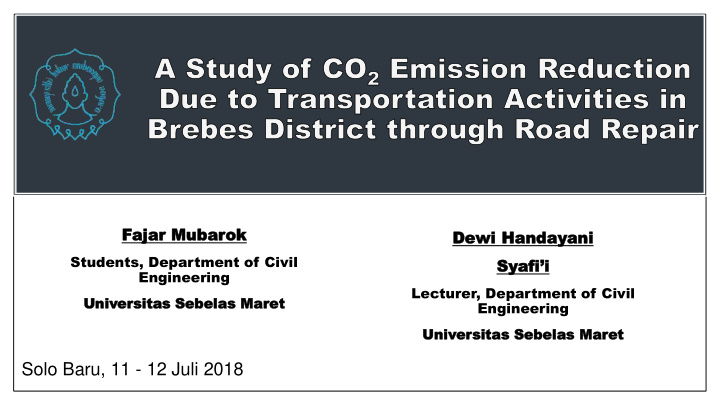



Fajar ajar Mu Mubar barok ok Dew ewi i Ha Hand nday ayan ani Students, Department of Civil Syafi’i Engineering Lecturer, Department of Civil Univ niver ersitas itas Sebel belas as Mar aret et Engineering Univ niver ersitas itas Sebelas belas Mar aret et Solo Baru, 11 - 12 Juli 2018
Background Objective OUTLINE Method Result and Discussion Conclusion
Bac Backg kground ound ▪ One of the biggest sectors contributing in the production of GRK is transportation. ▪ The provincial government of Central Java is targeting 12.5% CO 2 emission reduction from the transportation sector ▪ Traffic congestion and frequent stops in the flow of traffic has an impact on the increase of air pollution caused by emissions of motor vehicle exhaust
Bac Backg kground ound ▪ On the other hand the road roughness, road conditions and horizontal geometric design also affect the speed of vehicles. Rougher road surfaces can lead to higher vehicle emissions The comparison between very poor road conditions and excellent road conditions indicates a 2.49% increase in average vehicle emissionss on very poor road conditions low mean speed produced higher CO 2 emission rates and it increased even more on roads with high speed dispersal
Bac Backg kground ound Fuel CO 2 PCI Speed Consumption emission ▪ Due to the fact that road condition affect the speed of vehicles on the road and impact CO 2 emission, further research is needed
Objective ✓ This study aims to obtain the relationship between CO 2 emission from vehicle activity and urban road condition. ✓ To find out how much carbon CO 2 emission decrease, by raising the value of PCI
Method Method Assessing road condition using the Pavement Condition Index method (PCI) Calculating the fuel consumption of each type of vehicle using the equation of Pacific Consultant International Calculating CO 2 emissions using the equation from International Panel on Climate Change (IPCC)
Assessment using PCI 1. Divide the road segment per 100 m on the road of research object, 2. Measurement of the quantity of damage types, 3. Determine the level of road damage that is low , medium, high, 4. Determining the level of damage (density), 5. Determining the deduct value, according to the DV curve reading,
Assessment using PCI (Cont.) 6. Determining the Total Deduct Value (TDV), 7. Determining Corrected Deduct Value (CDV), according to the reading of graphs of TDV and CDV relationships, 8. Determining the PCI value of each segment.
Calculation of fuel consumption ▪ Calculation of fuel consumption involves a calculation model developed by the Pacific Consultant International ▪ Travel speed becomes the variable in fuel usage ▪ The data of travel speed is obtained by a survey using a vehicle model method
Calculation of CO 2 emissions ▪ To calculate CO 2 emission, some data is required, such as number of vehicles, vehicle type, fuel type, emission factor, and level of fuel consumption for each type of vehicle ▪ The data on the number and type of vehicles is obtained through manual traffic surveys ▪ Type of vehicle are grouped into 3 groups of motor vehicles according to MKJI 1997; motorcycle (MC), low vehicle (LV) and heavy vehicle (HV). Low vehicles are divided into two types based on the type of fuel used, namely either diesel or gasoline
Calculation of CO 2 emissions (Cont.) ▪ The emission factor used in the calculation of CO 2 emissions is the national emission factor according to the Minister of Environment Regulation No. 12/2010 on Air Pollution Control in the Region
Results and Discussions ▪ Pavement Condition Index (PCI) Length width PCI No Roads Damage levels m m Average 1 Jl. Songgom 9200 5 20,4 VERY POOR 2 Jl. Pramuka 1200 5 37,5 POOR 3 Jl. Abimanyu 1000 5 41,4 FAIR 4 Jl. Ahmad Dahlan 1200 5 65,7 GOOD 5 Jl. Ronggowarsito 3500 5 79,5 VERY GOOD 6 Jl. Sultan Agung 2500 6 83,6 VERY GOOD
▪ Impact of Road Damage on Travel Speed All types of vehicles show a relationship between road damage and their speed of travel. There is an up to 57% decrease of speed on very poor road conditions compared to on very good road conditions
▪ Correlation of road condition and CO 2 emissions The relationship CO 2 emissions (g/km) fuel V average Average LV between speed of Roads PCI cons. LV (km/h) (g/km) MC Gasolin HV (lt/km) Diesel e travel and fuel Jl. Songgom 20,4 17,6 0,376 60,80 412,60 1617,79 1732,07 955,81 consumption is Jl. Pramuka 37,5 20,4 0,353 58,19 388,89 1517,06 1629,29 898,36 inversely Jl. Abimanyu 41,4 21,4 0,343 57,30 378,73 1473,90 1581,94 872,97 proportional. Fast- Jl. Ahmad Dahlan 65,7 25,9 0,309 55,31 343,23 1323,41 1417,88 784,96 moving vehicles will Jl. Ronggowarsito 79,5 29,2 0,282 52,03 318,65 1219,50 1277,72 716,98 consume less fuel. Jl. Sultan Agung 83,6 31,1 0,269 51,54 302,24 1150,23 1233,68 684,42 Fuel consumption of each type of vehicle certainly affects the resulting CO 2 emissions. High fuel consumption levels will result in high CO 2 emissions as well.
▪ Correlation of road condition and CO 2 emissions (Cont.) Increasing the value of PCI by 10 points from the lowest value will reduce CO 2 emissionss by 3.36% for gasoline-fueled vehicles.
Conclusion ▪ There is a correlation between road conditions, travel speed and production of CO 2 emissions by vehicles.Road damage can affect the travel speed of vehicles. ▪ Very poor road conditions led to a 57% reduction in travel speed compared to very good road conditions.
Conclusion (Cont.) ▪ The decrease in speed leads to an increase in fuel consumption. Higher fuel consumption will cause higher CO 2 emissions as well. ▪ Increasing the value of PCI by 10 points from the lowest value will reduce CO 2 emissions by 3.36% for gasoline- fueled vehicles.
Thank You
Recommend
More recommend